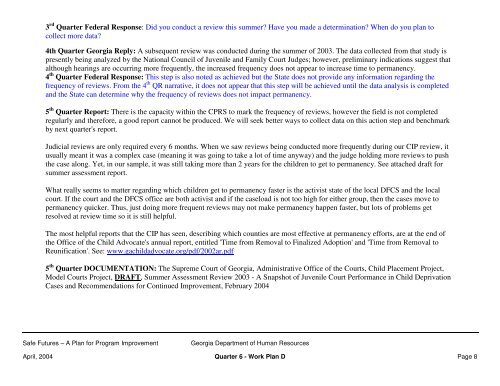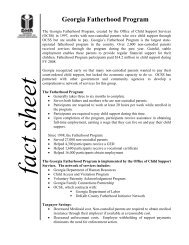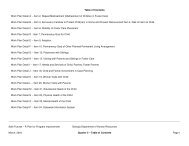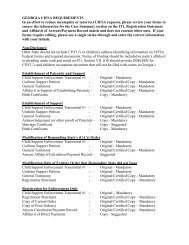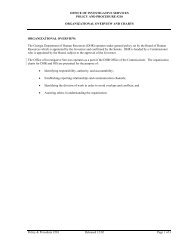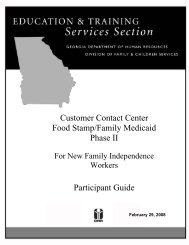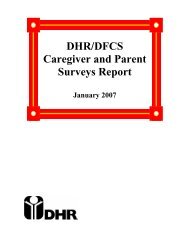Table of Contents - Department of Human Services
Table of Contents - Department of Human Services
Table of Contents - Department of Human Services
You also want an ePaper? Increase the reach of your titles
YUMPU automatically turns print PDFs into web optimized ePapers that Google loves.
3 rd Quarter Federal Response: Did you conduct a review this summer? Have you made a determination? When do you plan to<br />
collect more data?<br />
4th Quarter Georgia Reply: A subsequent review was conducted during the summer <strong>of</strong> 2003. The data collected from that study is<br />
presently being analyzed by the National Council <strong>of</strong> Juvenile and Family Court Judges; however, preliminary indications suggest that<br />
although hearings are occurring more frequently, the increased frequency does not appear to increase time to permanency.<br />
4 th Quarter Federal Response: This step is also noted as achieved but the State does not provide any information regarding the<br />
frequency <strong>of</strong> reviews. From the 4 th QR narrative, it does not appear that this step will be achieved until the data analysis is completed<br />
and the State can determine why the frequency <strong>of</strong> reviews does not impact permanency.<br />
5 th Quarter Report: There is the capacity within the CPRS to mark the frequency <strong>of</strong> reviews, however the field is not completed<br />
regularly and therefore, a good report cannot be produced. We will seek better ways to collect data on this action step and benchmark<br />
by next quarter's report.<br />
Judicial reviews are only required every 6 months. When we saw reviews being conducted more frequently during our CIP review, it<br />
usually meant it was a complex case (meaning it was going to take a lot <strong>of</strong> time anyway) and the judge holding more reviews to push<br />
the case along. Yet, in our sample, it was still taking more than 2 years for the children to get to permanency. See attached draft for<br />
summer assessment report.<br />
What really seems to matter regarding which children get to permanency faster is the activist state <strong>of</strong> the local DFCS and the local<br />
court. If the court and the DFCS <strong>of</strong>fice are both activist and if the caseload is not too high for either group, then the cases move to<br />
permanency quicker. Thus, just doing more frequent reviews may not make permanency happen faster, but lots <strong>of</strong> problems get<br />
resolved at review time so it is still helpful.<br />
The most helpful reports that the CIP has seen, describing which counties are most effective at permanency efforts, are at the end <strong>of</strong><br />
the Office <strong>of</strong> the Child Advocate's annual report, entitled 'Time from Removal to Finalized Adoption' and 'Time from Removal to<br />
Reunification'. See: www.gachildadvocate.org/pdf/2002ar.pdf<br />
5 th Quarter DOCUMENTATION: The Supreme Court <strong>of</strong> Georgia, Administrative Office <strong>of</strong> the Courts, Child Placement Project,<br />
Model Courts Project, DRAFT, Summer Assessment Review 2003 - A Snapshot <strong>of</strong> Juvenile Court Performance in Child Deprivation<br />
Cases and Recommendations for Continued Improvement, February 2004<br />
Safe Futures – A Plan for Program Improvement<br />
Georgia <strong>Department</strong> <strong>of</strong> <strong>Human</strong> Resources<br />
April, 2004 Quarter 6 - Work Plan D Page 8


